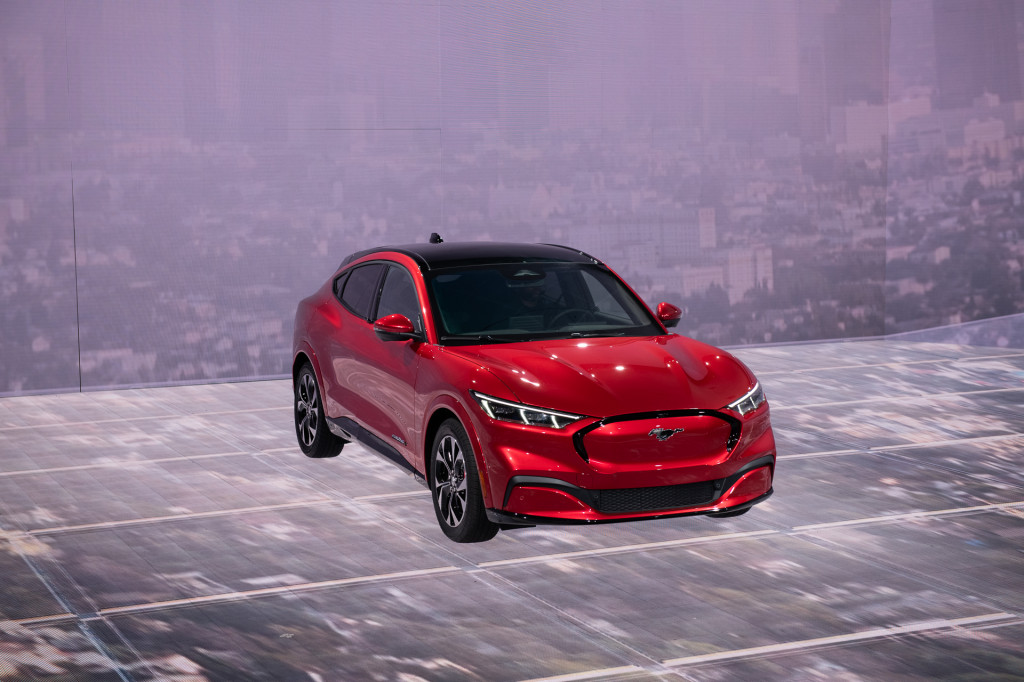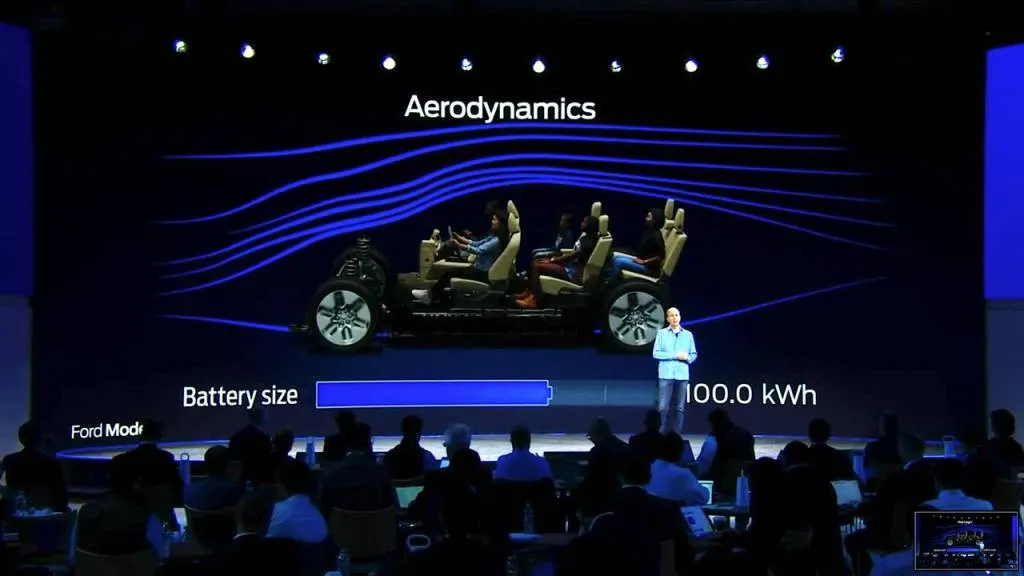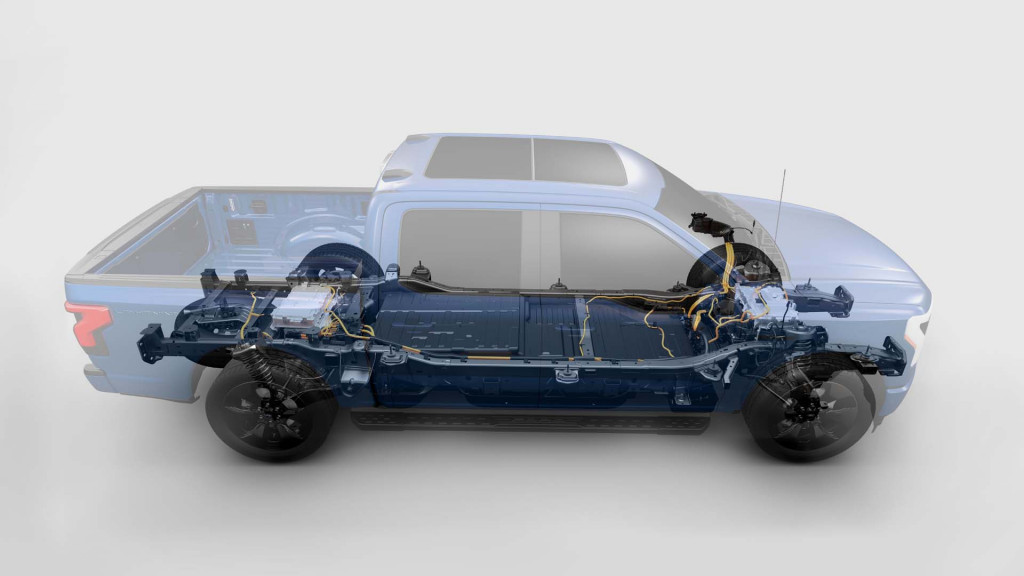Ford CEO Jim Farley on Monday teased the automaker’s upcoming fully electric seven-passenger SUV as being “like your own personal bullet train.”
While that might not have been quite as extraordinary a picture as the Millennium Falcon with a back porch he likened Ford’s upcoming Project T3 electric pickup to in March, the two descriptions together signal that the automaker is attempting to create something very different, if not downright disruptive, with these next-generation Model E electric vehicles.
Both are due to arrive in 2025, as the harbingers of Ford’s Generation 2 EV architecture. And at Ford’s Capital Markets Day on Monday, Farley, along with product development chief and CTO Doug Field, walked shareholders through what will make these EVs special.

2021 Ford Mustang Mach-E, 2019 LA Auto Show
Ford EVs: From scrappy to groundbreaking?
“Ford’s Generation 1 was a scrappy endeavor: Low investment, really small teams, and pushing against a large organization that hadn’t really endorsed or embraced EVs yet,” summed Field, who nevertheless called them “great products” and partly why he came to Ford from Tesla.
With the F-150 Lightning, Ford went well beyond taking the F-150 and making it electric, Field explained—also making it out-accelerate most sports cars, offer a frunk larger than that of most sedans, and stake out a first-in-market position for home backup power.
“Now our Gen 2 products we’ll take a lot further. We’ll invest in Gen 2 only in those places and segments where we know we can win…starting with a full-size pickup that goes to the next level, and a three-row SUV,” he explained. “Our Gen 2 products will be unlike anything customers have ever seen; that starts by not trying to be everything to everyone and make every possible flavor for every individual.”
“Our Gen 2 three-row, which is also coming in 2025, will be equally groundbreaking,” Field said, comparing it to the T3.

2025 Ford 3-row SUV - not going to be an Expedition EV
No Expedition EV—maybe not even an Explorer EV
With that, Field described what’s coming—and he essentially dashed the likelihood of seeing Ford mainstays like Expedition or Explorer as an EV.
“So think about a family that wants an affordable EV with an amazing experience for road trips,” said Field. “Now we could have converted an Expedition into an EV but it wouldn't have made for a very good EV and it wouldn't have made for a very good Expedition.”
To get 300 miles of range on the highway in an Expedition would have taken about 150 kwh of battery—a big, expensive, heavy battery, he explained, suggesting that the resulting product simply wouldn’t stand out enough versus ICE products.
EV efficiency is more important than range
“There's a bit of an arms race in the industry to shove bigger and bigger batteries into large EVs to try and make them like ICE vehicles,” said Field. “But the real battleground in electrification is about efficiency.”
“We optimize it rather than compromise it,” summed Field. “When we set out to build our Generation 2 three-row we started by changing the way we think about the tires with lower rolling resistance, squeezing every little drop of propulsion system efficiency out. And in computer simulations we took a bunch of mass out, we lowered the right height, changed the aerodynamics. And the result is a different product.”
The result, said Field, is a three-row family vehicle with 350 miles of range from a 100-kwh battery pack, that can still cover 300 miles when cruising at 70 mph. “It’s got a battery that’s one-third smaller, lighter, thousands of dollars less expensive, and with the same amount of scarce battery raw materials we can bring our product to three customers instead of two.”

Ford Gen 2 electric SUV starting point

Ford Gen 2 electric SUV after efficiency improvements
“We’ve engineered the battery and charging so not only can you travel those distances on the highway but you can stop for less than 10 minutes and pick up 150 miles of range,” Field said.
It won’t look like an Expedition either. In addition to Farley’s bullet-train comment and the hints about aero, Field said that the product is beautiful and unlike anything in the segment, and it will be longer, sleeker, quieter and quieter vehicle with an extremely spacious interior.
Fields also said that its next-gen platform software and hardware will launch first on its Gen 2 Model E products in 2025, enabling Level 3 autonomous-driving functionality, as well as incremental improvements to vehicle range.
These will be high-production-volume models. Replying to a question asked by Morgan Stanley’s Adam Jonas, Farley confirmed an anticipated annual production volume for its Model E EVs at 1.2 to 1.3 million annually by the end of 2026.

2022 Ford F-150 Lightning
Alongside a streamlined Ford electric pickup
Expectations are high for the 2025 electric pickup, which will no longer be closely aligned with the F-150. Farley again teased the upcoming Ford electric truck as “a technology tour de force that will transform the job site.”
Field talked about finding inspiration for these vehicles not just in the competition but “from the limits of physics” and from other industries—and he, as Farley did earlier in the year, pointed to radically simplified builds and build combinations.
“The complexity goes so far in this new project that you'll be able to count the buildable combinations on two hands,” said Field, noting that includes retail and Ford Pro customers. “So when we commit to this kind of focus, complexity falls off in a way that completely changes the company.”
That frees up all sorts of costs, but the most significant benefit is that Ford can do more with the product with that focus, Field explained.
What exactly that is remains to be seen, but making sure its EVs go farther with less is a very good start.













